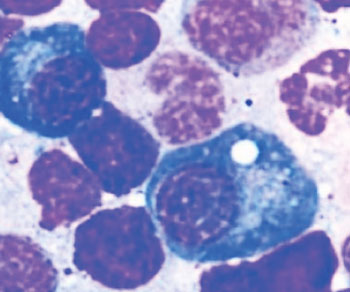Long-Lived Antibody-Producing Cells Identified in Bone Marrow
By LabMedica International staff writers
Posted on 04 Aug 2015
A distinct set of long-lived antibody-producing cells have been identified in the human bone marrow that function as an immune archive.Posted on 04 Aug 2015
These cells keep a catalog of how an adult's immune system responded to infections decades ago in childhood encounters with measles or mumps viruses and these findings could advance investigation of autoimmune diseases such as lupus erythematosus or rheumatoid arthritis, by better defining the cells that produce auto-reactive antibodies.

Image: Long-lived plasma cells have a distinctive \"fried egg\" appearance, containing bubble-like vacuoles or lipid droplets, which are generally rare in bone marrow cell samples (Photo courtesy of Emory University).
A large team of scientists led by those at Emory University (Atlanta, GA, USA) obtained bone marrow aspirates from 35 healthy adults, age 22 to 70 years. Eleven of these subjects were in the age range of 43 to 70 years and were recruited due to high serum titers of measles or mumps from history of natural infection with measles and mumps viruses during childhood. All adult subjects were vaccinated with the influenza vaccine one to 11 months prior to BM aspirates. Blood and bone marrow aspirate was obtained from each patient and mononuclear cells were isolated by density gradient centrifugation.
The investigators used CD19, CD38, and CD138 to identify four plasma cell (PC) subsets in human bone marrow (BM). They found that the CD19−CD38hiCD138+ subset (subset D) was morphologically distinct, differentially expressed PC-associated genes, and exclusively contained PCs specific for viral antigens to which the subjects had not been exposed for more than 40 years. Protein sequences of measles- and mumps-specific circulating antibodies were encoded for by CD19−CD38hiCD138+ PCs in the BM. They also found that CD19−CD38hiCD138+ PCs had a distinct ribonucleic acid (RNA) transcriptome signature and human immunoglobulin heavy chain (VH) repertoire that was relatively uncoupled from other BM PC subsets and probably represents the B cell response’s “historical record” of antigenic exposure.
Compared with other subsets, subset D cells are more quiescent as they displayed less signs of proliferation. In addition, subset D cells have a distinct "fried egg" appearance, containing bubble-like vacuoles or lipid droplets, which are rare in bone marrow cell samples, and a tighter, more condensed nucleus than other white blood cells. In the patients examined, antibody genes from subset D were much more diverse than those from other plasma cells. The study was published on July 14, 2015, in the journal Immunity.
Related Links:
Emory University










 (3) (1).png)



